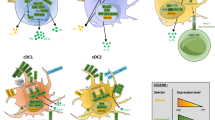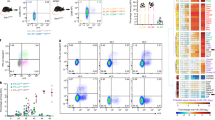Abstract
Plasmacytoid dendritic cell (pDC) precursors, also called type I IFN (α/β/ω)-producing cells (IPCs), are the key effectors in the innate immune system because of their extraordinary capacity to produce type I IFNs against microbial infection, particularly viral infection. In contrast to myeloid DCs, human pDC/IPCs selectively express Toll-like receptor (TLR) 7 and TLR9 within the endosomal compartment. These receptors are specifically designed to recognize the nucleoside-based products derived from RNA viruses and DNA viruses. Therefore, this expression profile potentially enables pDC/IPCs to sense a variety of viruses. Stimulation of TLR7 or TLR9 leads to type I IFN responses through the MyD88 pathway. Thus, pDC/IPCs may play a central role in host defense against viral infection through the TLR7 and TLR9 system.


Similar content being viewed by others
References
Grouard G, Rissoan MC, Filgueira L, et al (1997) The enigmatic plasmacytoid T cells develop into dendritic cells with interleukin (IL)-3 and CD40-ligand. J Exp Med 185:1101
Siegal FP, Kadowaki N, Shodell M, et al (1999) The nature of the principal type I interferon-producing cells in human blood. Science 284:1835
Liu YJ (2001) Dendritic cell subsets and lineages, and their functions in innate and adaptive immunity. Cell 106:259
Liu YJ, Kanzler H, Soumelis V, et al (2001) Dendritic cell lineage, plasticity and cross-regulation. Nat Immunol 2:585
Res PC, Couwenberg F, Vyth-Dreese FA, et al (1999) Expression of pTα mRNA in a committed dendritic cell precursor in the human thymus. Blood 94:2647
Rissoan MC, Duhen T, Bridon JM, et al (2002) Subtractive hybridization reveals the expression of immunoglobulin-like transcript 7, Eph-B1, granzyme B, and 3 novel transcripts in human plasmacytoid dendritic cells. Blood 100:3295
Schotte R, Rissoan MC, Bendriss-Vermare N, et al (2003) The transcription factor Spi-B is expressed in plasmacytoid DC precursors and inhibits T-, B-, and NK-cell development. Blood 101:1015
Bogdan C (2000) The function of type I interferons in antimicrobial immunity. Curr Opin Immunol 12:419
Kadowaki N, Antonenko S, Lau JYN, et al (2000) Natural interferon α/β-producing cells link innate and adaptive immunity. J Exp Med 192:219
Ito T, Amakawa R, Inaba M, et al (2004) Plasmacytoid dendritic cells regulate Th cell responses through OX40 ligand and type I IFNs. J Immunol 172:4253
Jarrossay D, Napolitani G, Colonna M, et al (2001)Specialization and complementarity in microbial molecule recognition by human myeloid and plasmacytoid dendritic cells. Eur J Immunol 31:3388
Krug A, Towarowski A, Britsch S, et al (2001) Toll-like receptor expression reveals CpG DNA as a unique microbial stimulus for plasmacytoid dendritic cells which synergizes with CD40 ligand to induce high amounts of IL-12. Eur J Immunol 31:3026
Kadowaki N, Ho S, Antonenko S, et al (2001) Subsets of human dendritic cell precursors express different toll-like receptors and respond to different microbial antigens. J Exp Med 194:863
Medzhihtov R, Janeway Jr C (2000) Innate immune recognition: mechanism and pathways. Immunol Rev 173:89
Aderem A, Ulevitch RJ (2000) Toll-like receptors in the induction of the innate immune response. Nature 406:782
Akira S, Takeda K, Kaisho T (2001) Toll-like receptors: critical proteins linking innate and acquired immunity. Nat Immunol 2:675
Kaisho T, Akira S (2001) Dendritic-cell function in toll-like receptor- and MyD88-knockout mice. Trends Immunol 22:78
Akira S, Takeda K (2004) Toll-like receptor signaling. Nat Rev Immunol 4:499
Wagner H (2004) The immunobiology of the TLR9 subfamily. Trends Immunol 25:381
Poltorak A, He X, Smirnova I (1998) Defective LPS signaling in C3H/HeJ and C57BL/10ScCr mice: mutations in Tlr4 gene. Science 282:2085
Schwandner R, Dziarski R, Wesche H, et al (1999) Peptidoglycan- and lipoteichoic acid-induced cell activation is mediated by toll-like receptor 2. J Biol Chem 274:17406
Takeuchi O, Sato S, Horiuchi T, et al (2002) Role of toll-like receptor 1 in mediating immune response to microbial lipoproteins. J Immunol 169:10
Takeuchi O, Kawai T, Muhlradt PF, et al (2001) Discrimination of bacterial lipoproteins by Toll-like receptor 6. Int Immunol13:933
Hayashi F, Smith KD, Ozinsky A, et al (2001) The innate immune response to bacterial flagellin is mediated by Toll-like receptor 5. Nature 410:1099
Hemmi H, Takeuchi O, Kawai T, et al (2000) A Toll-like receptor recognizes bacterial DNA. Nature 408:740
Bauer M, Redecke V, Ellwart JW, et al (2001) Human TLR9 confers responsiveness to bacterial DNA via species-specific CpG motif recognition. Proc Natl Acad Sci USA 98:9237
Hemmi H, Kaisho T, Takeuchi O, et al (2002) Small anti-viral compounds activate immune cells via TLR7-MyD88-dependent signaling pathway. Nat Immunol 3:196
Lund JM, Alexopoulou L, Sato A, et al (2004) Recognition of single-stranded RNA viruses by Toll-like receptor 7. Proc Natl Acad Sci USA 101:5598
Heil F, Hemmi H, Hochrein H, et al (2004) Species-specific recognition of single-stranded RNA via toll-like receptor 7 and 8. Science 303:1526
Diebold SS, Kaisho T, Hemmi H, et al (2004) Innate antiviral responses by means of TLR7-mediated recognition of single-stranded RNA. Science 303:1529
Crozat K, Beutler B (2004) TLR7: a new sensor of viral infection. Proc Natl Acad Sci USA 101:6835
Jarrossay D, Napolitani G, Colonna M, et al (2001) Specialization and complementarity in microbial molecule recognition by human myeloid and plasmacytoid dendritic cells. Eur J Immunol 31:3388
Krug A, Towarowski A, Britsch S, et al (2001) Toll-like receptor expression reveals CpG DNA as a unique microbial stimulus for plasmacytoid dendritic cells which synergizes with CD40 ligand to induce high amounts of IL-12. Eur J Immunol 31:3026
Hornung V, Rothenfusser S, Britsch S, et al (2002) Quantitative expression of Toll-like receptor 1–10 mRNA in cellular subsets of human peripheral blood mononuclear cells and sensitivity to CpG oligodeoxynucleotides. J Immunol 168:4531
Kadowaki N, Ho S, Antonenko S, et al (2001) Subsets of human dendritic cell precursors express different toll-like receptors and respond to different microbial antigens. J Exp Med 194:863
Agrawal S, Agrawal A, Doughty B, et al (2003) Different Toll-like receptor agonists instruct dendritic cells to induce distinct Th responses via differential modulation of extracellular signal-regulated kinase-mitogen-activated protein kinase and c-Fos. J Immunol 171:4984
Re F, Strominger JL (2001) Toll-like receptor 2 (TLR2) and TLR4 differentially activate human dendritic cells. J Biol Chem 276:37692
Ito T, Amakawa R, Kaisho T, et al (2002) Interferon-α and interleukin-12 are induced differentially by Toll-like receptor 7 ligands in human blood dendritic cell subsets. J Exp Med 195:1507
Kadowaki N, Antonenko S, Liu YJ (2001) Distinct CpG DNA and polyinosinic-polycytidylic acid double-stranded RNA, respectively, stimulate CD11c- type 2 dendritic cell precursors and CD11c+ dendritic cells to produce type I IFN. J Immunol 166:2291
Krug A, Rothenfusser S, Hornung V, et al (2001) Identification of CpG oligonucleotide sequences with high induction of IFN-α/β in plasmacytoid dendritic cells. Eur J Immunol 31:2154
Ahmad-Nejad P, Hacker H, Rutz M, et al (2002) Bacterial CpG-DNA and lipopolysaccharides activate Toll-like receptors at distinct cellular compartments. Eur J Immunol 32:1958
Heil F, Ahmad-Nejad P, Hemmi H, et al (2003) The Toll-like receptor 7 (TLR7)-specific stimulus loxoribine uncovers a strong relationship within the TLR7, 8 and 9 subfamily. Eur J Immunol 33:2987
Matsumoto M, Funami K, Tanabe M, et al (2003) Subcellular localization of Toll-like receptor 3 in human dendritic cells. J Immunol 171:3154
Latz E, Schoenemeyer A, Visintin A, et al (2004) TLR9 signals after translocating from the ER to CpG DNA in the lysosome. Nat Immunol 5:190
Miettinen M, Sareneva T, Julkunen I, et al (2001) IFNs activate toll-like receptor gene expression in viral infections. Genes Immun 2:349
Uehira K, Amakawa R, Ito T, et al (2002) Dendritic cells are decreased in blood and accumulated in granuloma in tuberculosis. Clin Immunol 105:296
Krug A, Luker GD, Barchet W, et al (2004) Herpes simplex virus type 1 activates murine natural interferon-producing cells through toll-like receptor 9. Blood 103:1433
Lund J, Sato A, Akira S, et al (2003) Toll-like receptor 9-mediated recognition of Herpes simplex virus-2 by plasmacytoid dendritic cells. J Exp Med 198:513
Salio M, Palmowski MJ, Atzberger A, et al (2004) CpG-matured murine plasmacytoid dendritic cells are capable of in vivo priming of functional CD8 T cell responses to endogenous but not exogenous antigens. J Exp Med 199:567
Tabeta K, Georgel P, Janssen E, et al (2004) Toll-like receptors 9 and 3 as essential components of innate immune defense against mouse cytomegalovirus infection. Proc Natl Acad Sci USA 101:3516
Alexopoulou L, Holt AC, Medzhitov R, et al (2001) Recognition of double-stranded RNA and activation of NF-kappaB by Toll-like receptor 3. Nature 413:732
Compton T, Kurt-Jones EA, Boehme KW, et al (2003) Human cytomegalovirus activates inflammatory cytokine responses via CD14 and Toll-like receptor 2. J Virol 77:4588
Rassa JC, Meyers JL, Zhang Y, et al (2002) Murine retroviruses activate B cells via interaction with toll-like receptor 4. Proc Natl Acad Sci USA 99:2281
Kurt-Jones EA, Popova L, Kwinn L, et al (2000) Pattern recognition receptors TLR4 and CD14 mediate response to respiratory syncytial virus. Nat Immunol 1:398
Du X, Poltorak A, Wei Y, et al (2000) Three novel mammalian toll-like receptors: gene structure, expression, and evolution. Eur Cytokine Netw 11:362
Jurk M, Heil F, Vollmer J, et al (2002) Human TLR7 or TLR8 independently confer responsiveness to the antiviral compound R-848. Nat Immunol 3:499
Bourke E, Bosisio D, Golay J, et al (2003) The toll-like receptor repertoire of human B lymphocytes: inducible and selective expression of TLR9 and TLR10 in normal and transformed cells. Blood 102:956
Wagner M, Poeck H, Jahrsdoerfer B, et al (2004) IL-12p70-dependent Th1 induction by human B cells requires combined activation with CD40 ligand and CpG DNA. J Immunol 172:954
Okada T, Lian ZX, Naiki M, et al (2003) Murine thymic plasmacytoid dendritic cells. Eur J Immunol 33:1012
Edwards AD, Diebold SS, Slack EM, et al (2003) Toll-like receptor expression in murine DC subsets: lack of TLR7 expression by CD8 alpha+ DC correlates with unresponsiveness to imidazoquinolines. Eur J Immunol 33:827
Boonstra A, Asselin-Paturel C, Gilliet M, et al (2003) Flexibility of mouse classical and plasmacytoid-derived dendritic cells in directing T helper type 1 and 2 cell development: dependency on antigen dose and differential toll-like receptor ligation. J Exp Med 197:101
Hoebe K, Du X, Georgel P, et al (2003) Identification of Lps2 as a key transducer of MyD88-independent TIR signalling. Nature 424:743
Yamamoto M, Sato S, Hemmi H, et al (2003) Role of adaptor TRIF in the MyD88-independent toll-like receptor signaling pathway. Science 301:640
Taniguchi T, Takaoka A (2002) The interferon-alpha/beta system in antiviral responses: a multimodal machinery of gene regulation by the IRF family of transcription factors. Curr Opin Immunol 14:111
Kerkmann M, Rothenfusser S, Hornung V, et al (2003) Activation with CpG-A and CpG-B oligonucleotides reveals two distinct regulatory pathways of type I IFN synthesis in human plasmacytoid dendritic cells. J Immunol 170:4465
Izaguirre A, Barnes BJ, Amrute S, et al (2003) Comparative analysis of IRF and IFN-alpha expression in human plasmacytoid and monocyte-derived dendritic cells. J Leukoc Biol 74:1125
Barchet W, Cella M, Odermatt B, et al (2002) Virus-induced interferon alpha production by a dendritic cell subset in the absence of feedback signaling in vivo. J Exp Med 195:507
Author information
Authors and Affiliations
Corresponding author
Rights and permissions
About this article
Cite this article
Ito, T., Wang, YH. & Liu, YJ. Plasmacytoid dendritic cell precursors/type I interferon-producing cells sense viral infection by Toll-like receptor (TLR) 7 and TLR9. Springer Semin Immun 26, 221–229 (2005). https://doi.org/10.1007/s00281-004-0180-4
Received:
Accepted:
Published:
Issue Date:
DOI: https://doi.org/10.1007/s00281-004-0180-4




